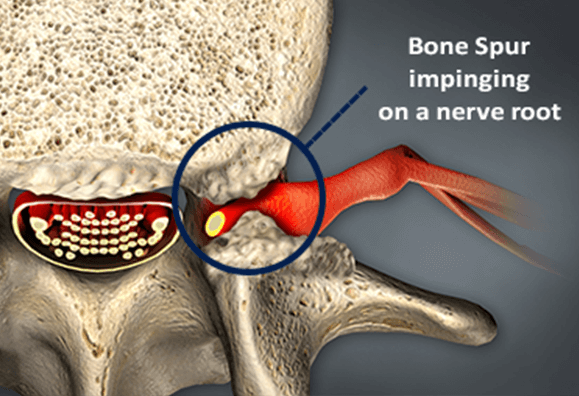Bone Spur/Osteophyte Symptoms
Bone spurs, or osteophytes, themselves are not painful. In fact, they may go undetected for years, not requiring any treatment. Where your bone spurs are located determines where you will feel pain and whether you will experience any other signs or bone spur symptoms.
What Are Bone Spurs?
Bone spurs are small enlargements of bone structure. This enlarged boney structure is often smooth and forms over a period of time on the edges of the bones near the joints. Bone spurs can be asymptomatic, but depending on their location they can result in debilitating pain.
Common Symptoms
By themselves, bone spurs are not painful. However, they can easily rub against nearby nerves or narrow the spaces between vertebrae, leading to nerve pinching and causing severe pain. Common bone spur symptoms will vary according to their location.
For instance, bone spurs that form on the vertebrae body in your spine may push against your spinal nerves, leading to pain and numbness in various parts of the body.
Cervical Bone Spurs
If the bone spur develops on the vertebrae in the cervical spine, it can lead to pain and stiffness in the neck area. Common cervical bone spur symptoms include:
- Sharp or radiating pain in the neck, shoulders and arms
- Headaches
- Numbness or tingling
- Weakness that radiates into the arms and hands
Thoracic Bone Spurs
If the bone spur develops on one of the vertebrae situated in the thoracic spine, it may cause discomfort in the center of the back, right behind the rib cage. Common thoracic bone spur symptoms include:
- Pain that radiates into the abdomen
- Radiating pain into arms and shoulders
- Pain and discomfort in the lower extremities
Lumbar Bone Spurs
If the bone spurs develop in the lumbar or lower back region, it can lead to stiffness and pain. Common lumbar bone spur symptoms include:
- Sciatica
- Lower back pain
- Tingling or numbness in the lower back area
- Weakness in the hips, buttocks, legs, and feet
Bone Spur Complications
As bone spurs progress and start compressing adjacent nerves, patients start experiencing neurological symptoms that can lead to severe spinal conditions. This may occur when bone spur symptoms have been ignored for a prolonged time or if they haven’t responded to conservative treatment. Some conditions that may be brought on by ignoring symptoms of bone spurs include:
Many severe bone spur symptoms are similar to the ones experienced with generalized arthritis, muscle fatigue, rheumatism, and nerve compressions or herniated discs. Because bone spur symptoms can be similar to other conditions, it’s essential to seek professional help to obtain an accurate diagnosis.
Loose Bodies and Joint Locking
Bone spurs can also break off from the larger bone, becoming what doctors call “loose bodies.” Often, loose bone spurs will float in your joint or become embedded in the lining of the joint.
Loose bodies can drift into the areas in between the bones that make up your joint, getting in the way and causing intermittent locking — a sensation that something is preventing you from moving your joint. Joint locking can come and go as the loose bodies move into and out of the way of your joint.
Conservative bone spurs treatment may provide temporary pain relief, however, surgery is the best way to remove bone spurs and decompress the affected nerves.

